From Words to Meaning: Mastering Text Parsing
 Purnima Msb
Purnima Msb
Have you ever tried explaining a complex idea to a friend and watched as their eyes glazed over? Or maybe you've sent a text that was completely misunderstood? Well, that’s where text parsing comes to the rescue! It's the superhero of language processing, breaking down sentences like a chef chopping onions, ensuring no tear is shed (okay, maybe just a few). Let’s dive into the world of text parsing, where we transform words into meaning, one step at a time.
1. Tokenization: Chopping It Up
Imagine you’ve got a delicious pizza in front of you. You wouldn’t just dive in; you’d slice it up first! Tokenization does exactly that with sentences. It breaks them down into smaller pieces—like chopping "I love pizza" into ["I", "love", "pizza"].
Why It Matters: This is the first step in understanding language. By getting down to each individual word, we start to unravel the delicious complexity of communication. No need for a pizza cutter, just a little token magic!
2. Part-of-Speech Tagging (POS): Who’s Who in the Sentence Zoo?
Now that we’ve got our tokens, let’s figure out who’s who. Part-of-Speech tagging is like assigning roles in a play. In our sentence "I love pizza," we identify each player: "I" is a pronoun (the main character), "love" is the action hero (the verb), and "pizza" is the tasty noun (the delicious object).
Why It Matters: Knowing the roles helps our AI actors understand the plot, leading to a well-structured script. Without it, you might end up with a pizza delivery gone wrong!
3. Named Entity Recognition (NER): Spotting the VIPs
Imagine attending a celebrity-filled party. You’d want to remember all the important people, right? Named Entity Recognition does just that for sentences. In "I visited New York in January," it spots the VIPs: "New York" (a cool city) and "January" (a month that’s always a bit chilly).
Why It Matters: Identifying names, places, and dates is crucial for catching the main points of a conversation. It helps our AI know where the party’s at and when to show up!
4. Dependency Parsing: The Web of Words
Now that we know who’s who, let’s examine how they relate. Dependency parsing looks at the relationships between words, like in the sentence "The cat chased the mouse." Here, "The cat" is the subject (the hunter), "chased" is the action (the chase), and "the mouse" is the object (the hunted).
Why It Matters: Understanding these connections helps AI grasp the full meaning of a sentence, not just the individual parts. Without this, you might get a cat chasing a dog—and that’s just chaos!
5. Lemmatization and Stemming: Keeping It Simple
Words can be fancy, but sometimes, we need to get back to basics. Lemmatization and stemming simplify words to their core. For example, "Running" and "runs" become "run."
Why It Matters: This ensures that different forms of a word are treated the same, making analysis easier. It’s like putting on your comfy shoes instead of those fancy heels!
6. Contextual Embedding: Reading Between the Lines
Context is everything! In "She can lead us," and "Lead is a metal," the word "lead" means something totally different. Contextual embedding helps AI figure out these subtleties, ensuring it doesn’t confuse a guide with a metal.
Why It Matters: By understanding context, AI becomes sharper and more accurate, leading to responses that are right on the money. No more awkward misunderstandings—unless it’s intentional!
7. Slot Filling: The Puzzle Solver
Picture trying to fill a jigsaw puzzle with pieces in the wrong places. Slot filling assigns specific bits of information to categories in a query. For "Book a flight to New York," it recognizes the intent (booking a flight) and slots in "destination" as "New York."
Why It Matters: This helps AI identify what it needs to fulfill tasks efficiently, like ensuring you don’t accidentally book a flight to Antarctica!
8. Dialogue State Tracking: The Memory Master
In a long conversation, it’s easy to forget what’s been said. Dialogue state tracking helps keep the flow intact. For example, if you say, "I’d like to book a flight," and the AI asks, "To where?" it remembers you’re planning a trip!
Why It Matters: This ensures that conversations feel natural and cohesive, so you don’t have to repeat yourself like a broken record. Trust me, no one enjoys that!
Final Thoughts: The Fun of Parsing
So there you have it—text parsing made fun! From breaking down sentences to understanding context, each step helps AI make sense of human language. The next time you send a text or have a chat with an AI, remember the behind-the-scenes magic at play, turning words into meaningful exchanges. Happy parsing!
Subscribe to my newsletter
Read articles from Purnima Msb directly inside your inbox. Subscribe to the newsletter, and don't miss out.
Written by
